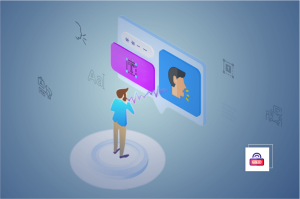Cloud Contact Center Software
If you want to offer customers great phone support, you’ll need an effective call center software that allows your service team to do their best work. Without this software, customers will wait on hold while agents struggle to answer queries.
Supervisors won’t be able to manage the chaos because they won’t have any insight into call volume or trends. The best call center software routes calls to the right agents, provides employees with additional context, and helps management execute an omni-channel strategy.
So, whether you’re a team of ten or a few hundred, choosing the right tools to build your call center is critical. This post breaks down common features of call center software and the best call center software options available this year.
Call Center Software Features
The best call center software for your team depends on your specific needs. Every tool has benefits and drawbacks depending on how you plan to use it. To understand which tool is right for you, draw up a list of desired features and then focus on your top choices. Below are a few features you might want to consider in your search.
1. Omnichannel
If you’re looking for a call center software, then you’re likely supporting your customers through other communication channels as well (like email, live chat, or social media). It’s important to consider how well your new call center software will integrate with your other channels.
HubSpot found that a unified customer service experience reduces customer friction and increases front line efficiency. Ideally, incoming calls should be logged on your help desk, which will allow agents to follow up via email. This feature will let everyone on your team see the context of previous customer interactions — regardless of the channel they took place on. As a result, you’ll create a consistent customer experience no matter which channel the interaction begins on.

2. Call Routing
When customers call your team, how do they get connected to the right person quickly? Whether your software offers automated call routing, or if customers need to select a department after listening to a set of options, it’s important to understand how your call routing will work. Many systems are complicated to update on the fly — so try setting up and changing your workflow during your trial period to make sure you’re not stuck with one configuration.
3. CRM Integration for Customer Context
Customers find it frustrating to repeat their issue to different support reps, as well as provide a summary of their previous interactions. But when agents have more context about the customer who’s calling, they can provide more effective support.
They can quickly reference past interactions with the customer, which prevents customers from having to repeat themselves. Agents can look at trends in product usage and take steps to ensure the customer doesn’t need to reach out again about the same issue.
Many call center tools provide context through CTI (computer-telephony integration) pop-ups that identify a customer through their phone number and surface previous interactions through the browser. Understanding how the software you’re evaluating logs calls and integrates with other systems (like your CRM) is critical to providing your agents with enough context to be helpful.
4.Cloud-Based Calling
Call centers operating on cloud networks will require a cloud-based calling system to align with their online databases. Cloud-based calling, or a Voice over Internet Protocol, (VoIP), is a phone system that runs through the internet instead of a phone line.
While a third-party provider typically offers this service, it’s usually cheaper to install and maintain than regular landlines. That’s because VoIP doesn’t require on-premise hardware, which removes the typical maintenance and infrastructure costs that traditional phone lines have.

5. Reporting
Running a call center requires managers to have a finger on the pulse of call center metrics like incoming call volume, call trends, and agent efficiency. It’s impossible to manage scheduling and plan for the future without knowing how your team is handling fluctuations in traffic. Reporting can identify common issues that customers are calling about, demonstrate gaps in your support coverage, and highlight potential training opportunities.
6. Outgoing Calls
Call center software isn’t just for inbound customer service. Agents might need to make outbound calls if you offer proactive customer support options. Sales teams might work through your call center software to place calls to prospects.
If your contact center also requires agents or sales teams to place outgoing calls, look for software that includes an automated dialer and easy-to-use call logging features so your CRM stays up to date.
7. Usage Pricing
Take a close look at the software’s pricing per phone call or per use. Depending on how your chosen software assigns your phone numbers, you might be charged more than expected for each minute on the phone. Before committing to any new phone lines, confirm what’s included in the package and how much each call and minute will cost.
8. Interactive Voice Response
An interactive voice response feature will allow your customers to speak with an automated system before reaching your support team. While your customer might not enjoy talking to a machine, they may get some of their issues resolved through this option or provide basic information that will allow your team to better serve them.
An IVR feature will help manage your team’s call volume and automatically collect relevant information from the customer. By the time the customer gets to a human, all the information the representative needs is already available, and the customer won’t have to repeat themselves.

9. Call Scripting
If you handle a high volume of calls that pertain to similar issues, you’ll want to consider a call center software that offers a call scripting feature. Like a chatbot, a call script picks up on certain keywords in the customer’s email and offers troubleshooting instructions based on a common answer. You should be able to look at the script history and personalize your response to the customer.
A call scripting feature could also come in handy because it could allow you to create common scripts that all of your agents can use. That way, the customer has a consistent experience regardless of the agent they’ve reached.
10. Escalation Management
The best call center software will allow you to manage the escalation process for urgent customer support queries. From the moment a customer calls with an issue, they should be able to move forward to the appropriate party at each step of the process.
Your call center software should also allow your agents to de-escalate issues by granting vouchers, discounts, or refunds through the software, and especially in that single call. Now that you know what to look for when evaluating call center software, let’s take a look at the best options available.





Pingback: Best Recovery and Backup Solutions for office 365 In 20222 - AbdulTech News
Hello,
Greetings from Ranker SEO.
Are you looking for a genuine SEO service to rank your website top on Google? Are you cheated by fake SEO companies?
You have found an affordable legitimate SEO agency to rank your website.
We have ranked 100s of websites such as blogs, shopify stores, ecommerce websites, adult websites, saas websites, etc. You can reach more customers by utilizing our backlinks.
For real proof, you can visit our website and check out. Contact us for more details.
Our Skype ID: support@ranker.one
Our Website: https://www.ranker.one
Thanks & Regards
Ranker SEO
If you don’t like to receive our messages, you can unsubscribe by click here https://www.ranker.one/unsubscribe/?site=eclgh.com